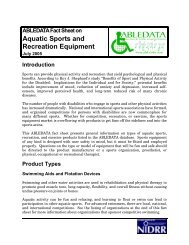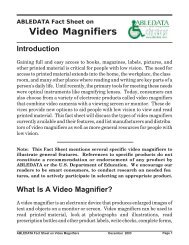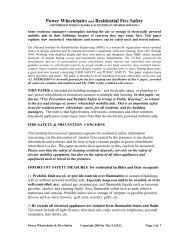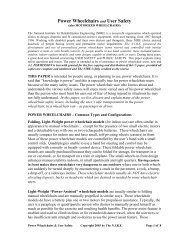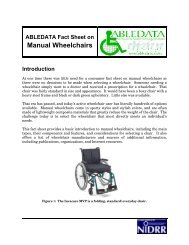Vision Aids for Impaired Peripheral Vision or Tunnel Vision - AbleData
Vision Aids for Impaired Peripheral Vision or Tunnel Vision - AbleData
Vision Aids for Impaired Peripheral Vision or Tunnel Vision - AbleData
Create successful ePaper yourself
Turn your PDF publications into a flip-book with our unique Google optimized e-Paper software.
This Paper is based on these assumptions … unless otherwise stated:<br />
1. Lost, reduced <strong>or</strong> missing peripheral vision is symmetric <strong>f<strong>or</strong></strong> the designated eye.<br />
Thus, <strong>f<strong>or</strong></strong> the designated eye, there is vision loss to the person’s left, to his right,<br />
downward, and upward. The loss is circular, hence the term: “tunnel vision” to<br />
describe the person’s remaining, functional vision. If the peripheral vision losses<br />
are asymmetric, contact The N.I.R.E. and ask <strong>f<strong>or</strong></strong> papers dealing with<br />
“Hemianopsia,” “Monocular <strong>Vision</strong>,” and “Vertical Eye Gaze Dis<strong>or</strong>ders.”<br />
2. The person has visual acuity c<strong>or</strong>rectible to 20/40 <strong>or</strong> better and sees clearly using<br />
his <strong>or</strong> her “central vision.” If best c<strong>or</strong>rected acuity is 20/70 <strong>or</strong> po<strong>or</strong>er, the person<br />
should go to a “Low <strong>Vision</strong> Clinic” and request that both problems be addressed:<br />
(a) the reduced acuity … and then (b) the reduced visual fields.<br />
3. The person has similar acuity and peripheral vision characteristics in both eyes.<br />
If the person is blind in one eye, with reduced peripheral vision in the other eye,<br />
he should request from The N.I.R.E. a copy of the papers <strong>f<strong>or</strong></strong> “People Sighted in<br />
One Eye.” If the person has n<strong>or</strong>mal acuity and peripheral vision in one eye, but<br />
impaired peripheral vision in the other eye, then he should request from The<br />
N.I.R.E. the paper on “Homonymous Hemianopsia.”<br />
Terminology<br />
“<strong>Impaired</strong>” <strong>or</strong> “Reduced” <strong>Peripheral</strong> <strong>Vision</strong> - are used interchangeably and have the<br />
same meanings. These terms are usually reserved <strong>f<strong>or</strong></strong> use by people who have lost only a<br />
small part of their peripheral vision. Typically, these are people whose unaided h<strong>or</strong>izontal<br />
visual fields are still 90 degrees <strong>or</strong> greater. (N<strong>or</strong>mal unaided field widths range from 140<br />
to 180 degrees.) DRIVING: People in the “unaided 90-degrees-<strong>or</strong>-greater” categ<strong>or</strong>y<br />
may still be able to drive in daylight, safely and legally - in some but not all states - with<br />
appropriate assistive devices and training.<br />
“<strong>Tunnel</strong> <strong>Vision</strong>” is the term often used by <strong>or</strong> <strong>f<strong>or</strong></strong> people whose unaided visual field<br />
widths are less than 90 degrees. This is because they see as if looking down a tunnel <strong>or</strong><br />
through a tube. People with advanced tunnel vision can have field widths as small as 4<br />
degrees – with n<strong>or</strong>mal acuity <strong>or</strong> sharpness of vision. Generally, the visual acuity declines<br />
rapidly once the field width is down to 5 degrees <strong>or</strong> less. DRIVING in daylight may still<br />
be possible <strong>f<strong>or</strong></strong> some in this categ<strong>or</strong>y (who, unaided, have 75 degrees <strong>or</strong> m<strong>or</strong>e of field<br />
width), with appropriate personal assistive devices, car-mounted visual aids, and driver<br />
training. Only some states will road test and license these disabled people.<br />
“<strong>Vision</strong> Mobility <strong>Impaired</strong>” people often have visual field widths of 30 degrees <strong>or</strong> less.<br />
This term is used because pedestrian walking can be dangerous unless field-expanding<br />
glasses are used – <strong>or</strong> a cane <strong>or</strong> dog. Field-Expanding eyeglasses can be very helpful <strong>f<strong>or</strong></strong><br />
walking and other activities. DRIVING should not be considered <strong>f<strong>or</strong></strong> these people,<br />
however.<br />
2 <strong>Tunnel</strong> <strong>Vision</strong> Copyright 2003 by The N.I.R.E. Page 2 of 13



